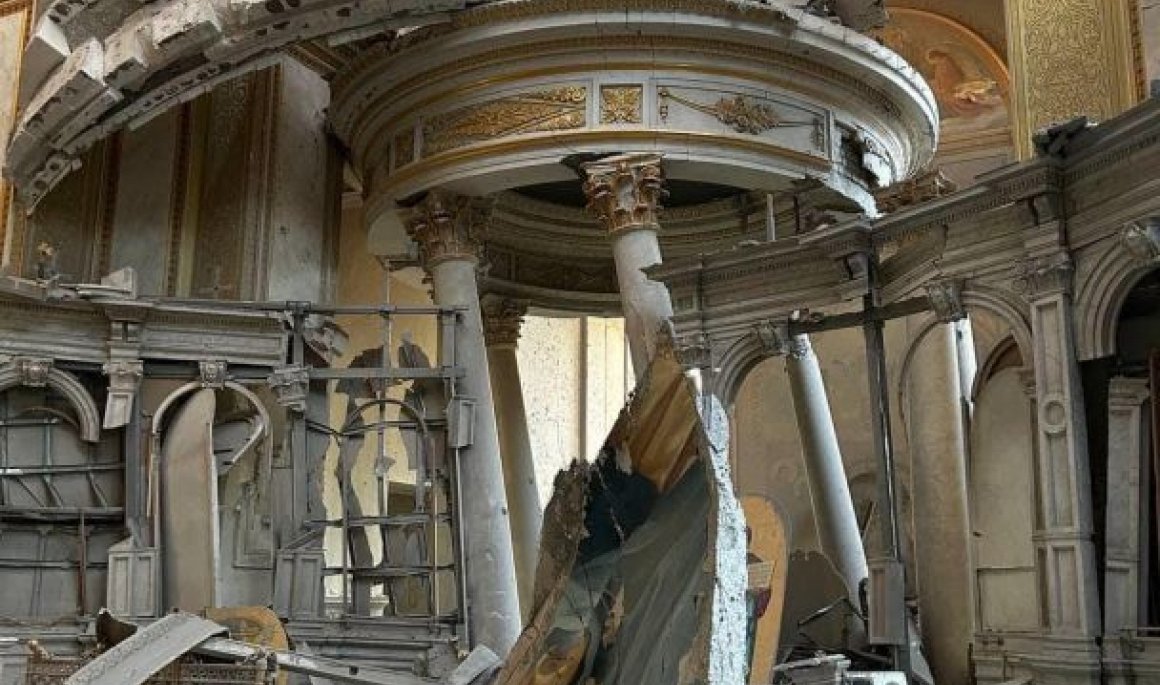- Norwich Blogs
- Blogs
- Targeting Churches: Waging War on Culture
Targeting Churches: Waging War on Culture
Disclaimer: These opinion pieces represent the authors’ personal views, and do not necessarily reflect the official policies or positions of Norwich University or PAWC.

On July 23rd, 2023, a Russian missile barrage aimed at the Ukrainian port city of Odesa seriously damaged the Cathedral of the Transfiguration, Odesa’s largest church and a UNESCO World Heritage site, along with other historic buildings in the center of the city. It remains to be determined if anything can be salvaged of the cathedral’s beautiful polychrome marble interior and the famous carillon bells in the tower, as well as the precious art and religious icons that hung on the cathedral’s walls.
The bombing of the Cathedral of the Transfiguration adds one more structure to the 114 churches and religious sites in Ukraine whose destruction UNESCO has documented since Russia invaded in February 2022. The Institute for Religious Freedom in Ukraine estimates that the actual losses of Christian, Muslim, and Jewish religious buildings could be closer to 500, including churches, mosques, and synagogues that have been ruined as a result of their use as military bases, weapons storage facilities, or to conceal the firing positions of fighters.
Deliberate destruction of non-military targets is considered a war crime. The indiscriminate bombing of civilian infrastructure in the Russia-Ukraine conflict has horrified the world thanks to the courageous documentary work of photojournalists. But unlike other civilian buildings, attacks on religious structures have a particular motivation and their destruction has unique, long-term cultural consequences. Churches are often deliberately targeted as centuries-old symbols of history, heritage, and faith, filled with priceless art and furnishings of deep meaning to the local community. Unlike hospitals and schools, churches and their contents cannot easily be rebuilt or replaced. An attack on a church, mosque, synagogue, or temple is more than just another civilian building destroyed, it is a symbolic attack on cultural identity. Destruction of religious buildings is a key component in the definition of cultural genocide.
As a scholar of German history, I have seen this pattern play out repeatedly in wars and conflicts over many centuries. The Nazi action against the Jews of Germany began in November 1938 with Kristallnacht, the “night of broken glass,” when 1,400 synagogues were torched along with thousands of Jewish-owned homes and businesses to inaugurate a systematic eradication of Jewish culture in Germany. Christians have not been shy about desecrating and destroying the religious buildings of their fellow Christians, either. During the Napoleonic Wars of the early 1800s, French Catholic soldiers routinely looted then stabled their horses in Protestant churches in the German cities they passed through. Centuries earlier, during the Thirty Years War of 1618-1648, both Catholic and Protestant armies used church destruction as a means of cultural warfare, attacking and burning one another’s religious buildings. In this war, power conflicts between rulers affiliated with different Christian sects led to deliberate targeting of churches.
After a war ends, it often takes decades to rebuild the churches and other religious buildings destroyed in the conflict, if reconstruction is attempted at all. When funding is tight and needs are many, rebuilding cultural institutions like churches is understandably a lower priority than homes, schools, hospitals, and government buildings. Ironically, the Cathedral of the Transfiguration recently attacked in Odesa was rebuilt only twenty years ago, after the original building was destroyed in the 1930s by the Soviets following the Holodomor, a period of terror and famine carried out by Stalin to eliminate Ukrainian independence movements and force the collectivization of agriculture. Seventy years elapsed before the Cathedral of the Transfiguration was reconstructed in 2003 as a symbol of Ukrainian religious and cultural renewal, and now it appears it may be many more years before the Orthodox Christians of Odesa will be able to worship in their cathedral again.
The people of Dresden, Germany, experienced a similarly long lapse between the destruction of a culturally significant church and its reconstruction. The allied firebombing of Dresden in February 1945 killed 25,000 people and gutted Dresden’s city center, including the complete destruction of the Frauenkirche (Church of Our Lady), a unique central-plan Baroque church topped by a huge dome, one of the most spectacular examples of Protestant religious architecture in Europe and a symbol of the city. During the period of Soviet occupation followed by the East German political regime, other building and rebuilding projects took precedence and the Frauenkirche was left as a pile of rubble in memory of the war. The church was rebuilt in 2005, sixty years after its destruction. Builders salvaged 3,800 blocks of fire-blackened stone from the original exterior, giving the rebuilt church a checkered look but restoring Dresden’s distinctive historic skyline with the reconstructed dome.
Despite efforts to restore ruined churches to their pre-war glory, reconstructing a church does not always bring back its cultural significance, especially when several generations pass between destruction and reconstruction. The Frauenkirche in Dresden originally represented the strength of Protestant Christianity within a territory ruled by Catholics. As a pile of rubble after World War II, the church served for decades as a memorial to the lives and buildings lost in the 1945 bombings. The reconstructed church now symbolizes civic resilience and inter-religious toleration. These changing meanings illustrate the effects of church destruction: even if the rebuilt church looks identical to the pre-war building, its cultural significance and meaning will never be exactly the same. Sometimes the reconstructed church has an entirely different purpose, as is the case with Berlin’s medieval St. Nicholas Church, rebuilt by East Germany in 1981. The St. Nicholas Church has not functioned as a church since before its destruction in the 1940s. The building is a beautiful museum anchoring a reimagined historic city center in eastern Berlin, but its use and cultural meaning bear little connection to the religious purposes the St. Nicholas church fulfilled for 700 years up to World War II.
Damaged churches can be rebuilt. The Cathedral of Notre Dame in Paris – a UNESCO World Heritage site like the Cathedral of the Transfiguration – is undergoing restoration right now to recover from a devastating fire in July 2019. Notre Dame will reopen to visitors in 2025, thanks to generous donors and the concerted efforts of the French government in coordination with the Vatican. Unfortunately, even if the outcome of the Russia-Ukraine war allows Ukraine to remain an independent nation, the reconstruction of the Cathedral of Transfiguration in Odesa will likely take much longer. Churches and other cultural institutions like museums and libraries will surely fall far down the list of priorities as Ukraine attempts to rebuild its basic energy, transportation, housing, health care, and educational infrastructure. This is what makes the targeting of churches so devastating, and so difficult to recover from. Even if Russia fails in its endeavor to subjugate Ukraine, it will have succeeded in altering or permanently destroying the rich cultural and religious heritage represented by the Cathedral of the Transfiguration in Odesa and found in the churches and religious sites across Ukraine.
About the Author
Emily Fisher Gray is Professor of History at Norwich University. She specializes in early modern German cultural and religious history, religious coexistence, and church architecture.



